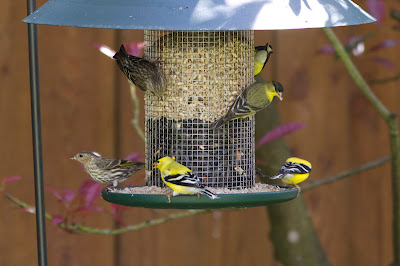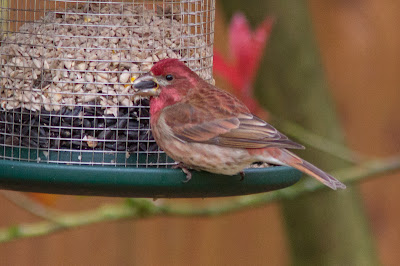I always like to begin posts with a photo that will catch the attention of the casual reader (yes, all three of you). I had been trying to get a nice photo of a male Rufous Hummingbird all spring and was fortunate to have two males fighting over the nectar feeder last Saturday. My opportunity finally arrived and I didn't hesitate to take advantage!
But as interesting as Rufous Hummers are, they're not the big story right now. Yesterday, I hosted the most impressive spring migratory morning that I can remember. It began at approximately 7:15 am when I spotted an Orange-crowned Warbler foraging through my neighbor's bushes. Orange-crowns are our most common summer warbler and the first large wave of them passed through earlier in the month, so this was interesting, but not incredibly so. Shortly afterwards, I noticed a larger bird hawking insects from the same tree. A look through the binoculars revealed a greenish-gray bird approximately 6" in length with a habit of cocking its tail. Definitely an Empidonax flycatcher. Flycatchers of this genus are notoriously difficult to identify. However, the long-ish, bi-colored bill and prominent eye ring strongly suggested a Pacific-slope Flycatcher. The only other Empid flycatcher with the same bill type that is found in this region in late April/early May is the Willow Flycatcher. Given that Willows have very faint eye rings and are grayer in color, I'm confident that this individual was a Pacific-slope. It came back to this tree a couple of times later in the morning but, unlike the Willow Flycatchers I've hosted in the past, stayed perched deep within the tree. So a photograph wasn't going to happen.
Thankfully, more photogenic birds were on their way. Approximately 10 minutes later, I spotted a pair of Wilson's Warblers in that same tree (what is it with this tree?). These individuals foraged through our yard afterwards, before moving elsewhere. Almost immediately afterwards, I spotted a MacGillivray's Warbler back in the neighbor's yard. It posed long enough in the neighbor's fir for a photo, before darting across the fence into our Wax Myrtle bushes. True to form, the MacGillivray's stayed low to the ground (they rarely forage above eye level). After a lull in the action, I stepped back inside and, after looking out the other window, noticed a Nashville Warbler in one of our Photinias. What a crazy morning!
This male MacGillivray's Warbler hangs out in our neighborhood for a while on a late April morning.
A Nashville Warbler joins the fun.
This blurry Wilson's Warbler was less cooperative with my camera. A better photo from last August can be found here.
As I was making a report of these sightings at my desk, I could see the MacGillivray's foraging through the ornamental shrubs in our front yard.
This crazy morning was rounded out by migratory sparrows. As mentioned in the last post, White-crowned Sparrows have been visiting in modest numbers. Some "pure" gambelli subspecies individuals were observed a couple of weeks ago, but we're now hosting an individual whose field marks suggest it's of mixed race. Interestingly, our overwintering tan-striped morph White-throated Sparrow was part of the Saturday madness as well. I'm somewhat surprised that it's still hanging around. Also present that morning were two Golden-crowned Sparrows. At least 2-3 different individuals have been frequenting the yard for the past couple of weeks.
This Golden-crowned Sparrow stocks up on seed before moving to its breeding grounds in Canada/Alaska
Not to be forgotten, the first Warbling Vireo of the year made its way through the yard last Tuesday. (It didn't want to pose for a photo, either.)
Other recent changes in the yard include the absence of many local wintering species, including Dark-eyed Juncos, Varied Thrushes, Townsend's Warblers, Purple Finches, Downy Woodpeckers, and Northern Flickers. Adding to the mix are American Goldfinches and House Finches, both of whom were unusually underrepresented this winter. Chestnut-backed Chickadees, who were also sporadic this past winter, have also made something of a comeback over the past week or so. (Perhaps a pair is nesting locally?) Approximately a dozen Pine Siskins continue to visit the feeders. I imagine that many of these individuals will breed locally this summer, which means that fledglings will be in the yard in another month or so. Small flocks of Evening Grosbeaks continue to nomadically roam around town, sometimes coming down to visit the feeders, sometimes not. They will begin to move into their breeding grounds in the foothills in another 2-3 weeks.
American Goldfinches, Lesser Goldfinches, and Pine Siskins visit the sunflower feeder.
As we get into May, we will enter the downslope of migratory movement. Black-headed Grosbeaks are in town (I saw one downtown this morning) and should be visiting the sunflower feeders any day now. Western Tanagers and Bullock's Orioles may also visit the yard over the next couple of weeks. Willow Flycatchers and Western Wood-Pewees will also make their way into the area by mid-May. It'll be interesting to see which of these visits the yard next.




























